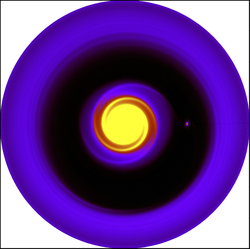Transitional disks are protoplanetary disks that contain annular gaps or inner holes, which may indicate they are being dynamically sculpted by forming protoplanets. But exactly how planets shape protoplanetary disks into transitional disks remains unclear.

In this work, we explore using hydrodynamical models what type of planet is necessary to open the observed gap (~13 AU) in the disk of HD 100546. We use radiative transfer models to constrain the shape of the outer edge of the gap from mid-infrared interferometric observations and the SED. The gap edge is seen to be rounded off, which is naturally explained by a gradual increase in surface density at the gap edge.
The extreme roundness of the gap edge in HD 100546, combined with it's depth, indicates both that the disk is very viscous, and that the planet needs to be very heavy. Instead, the observations are best explained by hydrodynamical simulations with a 60 Jupiter mass brown dwarf, though a super-Jupiter remains within the range of possibilities.
The extreme roundness of the gap edge in HD 100546, combined with it's depth, indicates both that the disk is very viscous, and that the planet needs to be very heavy. Instead, the observations are best explained by hydrodynamical simulations with a 60 Jupiter mass brown dwarf, though a super-Jupiter remains within the range of possibilities.
This article was also featured on astrobites!
link: Mulders et al. 2013b (arXiv)
related: Panic et al. 2014
link: Mulders et al. 2013b (arXiv)
related: Panic et al. 2014

 RSS Feed
RSS Feed
